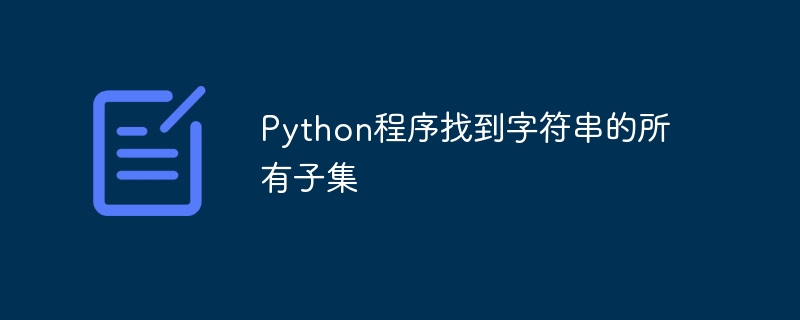Python程式找到字串的所有子集
- WBOYWBOYWBOYWBOYWBOYWBOYWBOYWBOYWBOYWBOYWBOYWBOYWB轉載
- 2023-09-23 21:33:041419瀏覽

在Python中,字串的子集是原始字串的一部分字元序列。我們可以使用Python中的itertools模組來找到字串的所有子集。在本文中,我們將看到如何透過對字串中的字元進行所有可能的組合來產生字串的所有子集。
文法
itertools.combination(string,r)
itertools模組的combination()函數接受字串和r,r代表可能的不同字串組合的大小。它傳回字串的所有可能的字元組合。
演算法
初始化一個稱為組合的空列表
使用 for 循環,使用 itertools.combination 函數產生字串中所有可能的字元組合。
過濾掉不是原始字串子集的內容
傳回子集
#Example
的中文翻譯為:範例
在下面的例子中,我們首先導入itertools模組來產生字串中所有可能的字元組合。 find_subsets()函數接受一個字串作為輸入,並傳回字串的所有可能子集。 find_subset()方法首先建立一個空列表來儲存所有的子集。然後透過for迴圈和itertools.combination()函數的幫助,它產生字串的所有可能子集,並將它們儲存在combination列表中。在產生並儲存了所有的組合之後,我們需要過濾掉不是原始字串的子集的字串,並將這樣的子集儲存在一個名為subset的清單中。這個子集然後被函數傳回作為字串的所有可能子集。
import itertools
def find_subsets(string):
# Get all possible combinations of characters in the string
combinations = []
for i in range(len(string) + 1):
combinations += itertools.combinations(string, i)
# Filter out the ones that are not subsets of the original string
subsets = []
for c in combinations:
subset = ''.join(c)
if subset != '':
subsets.append(subset)
return subsets
# Test the function
string = 'abc'
subsets = find_subsets(string)
print(subsets)
輸出
['a', 'b', 'c', 'ab', 'ac', 'bc', 'abc']
結論
在本文中,我們討論如何使用Python中的itertools模組產生字串的所有可能子集。一旦產生了字串中字元的所有可能組合,我們需要過濾掉不是原始字串子集的字串。結果,我們得到了字串的所有可能子集。
以上是Python程式找到字串的所有子集的詳細內容。更多資訊請關注PHP中文網其他相關文章!
陳述:
本文轉載於:tutorialspoint.com。如有侵權,請聯絡admin@php.cn刪除
上一篇:我可以用Python製作遊戲嗎?下一篇:我可以用Python製作遊戲嗎?

